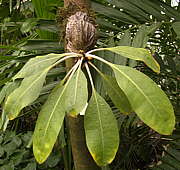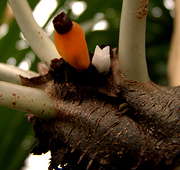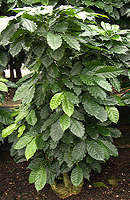 Coffea arabica Coffea arabicaRubiaceae de Jussieu 1789
The Rubiaceae is a family of about 650 genera including some 13,000 species of herbs and shrubby plants and the fourth largest family of flowering plants after the Asteraceae, Orchidaceae and Fabaceae.
Important members of the family include Coffea (coffee), Gardenia, Cinchona (Quinine and other alkaloids), Rubia tinctorum (source of Madder, a natural dye) and bedstraws.
Succulent genera: Several succulent caudiciform genera, Anthorhizza, Hydnophytum, Myrmecodia, Myrmephytum, Phylohydrax and Squamellaria have commensal relationships with ants which nest in cavities in tubers or stems.
|
Hydnophytum Jack 1823 (Ant Plants)
Name: Greek hydnon = truffle, tuber + phyton = plant
Hydnophytum is an interesting genus of choice epiphytic caudiciform plants, with 55 species widely distributed on islands around the Indian and Pacific oceans including the Anadaman islands, Fiji islands, South-East Asia and Queensland Australia.
In their habitat, holes in the caudex are colonised by ants that protect their adopted plant against pests and provide some nutrients from faeces and other waste. Special nutrient-absorbing glands are produced within specialised warty regions of the chambers. The ants preferentially leave their waste in these warty parts. This symbiotic relationship allows the plants to obtain more nutrients than could be provided by the limited root system.
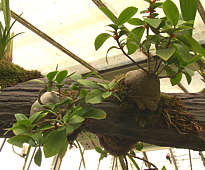
Some growers report that their local species of ants also make a home in these plants, although ants are not essential for these plants to grow. However, nutrients must be supplied in the form of fertiliser.
Hydnophytum species are best grown as epiphytes with the caudex completely exposed, on a bed of bark chippings (orchid compost) or secured to bark with some moss or osmunda fibre around the brittle roots to retain moisture. (Right)
These plants need continuous warmth with bright light. If conditions are not correct the caudex rapidly turns into a mush. As epiphytes, they need to be watered frequently, but allowed to dry out between waterings. When mounted on bark, watering should be more frequent. These plants can be propagated from cuttings of the branching stems, but it is not clear whether they will develop a proper caudex.
|
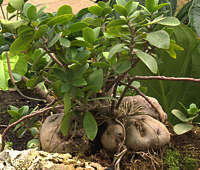 
Hydrophytum mosleyanum at RBG Kew.
Hydnophytum moseleyanum Beccari 1884
is an epiphyte native to Queensland, Australia and Papua, New Guinea where it grows on the branches of rainforest trees.
The swollen silvery caudex develops, with age, a maze of interconnecting internal chambers (domatia) some of which have openings to the surface. Within these chambers humidity and temperature are stable, providing an ideal environment for an ant colony.
Tiny white flowers with 4 petals are followed by bright orange berries containing 2 seeds.
Hydnophytum formicarum Jack 1823
the type species from the the Anadaman islands, Thailand, Malaysia and Sumatra is a very similar plant, but with a more upright dark-brown conical caudex than that of H. moseleyanum and has prominent ridges. The leaves have more (6-12) veins compared with 3-4 veins on those of H. moseleyanum. A traditional medicinal plant with cardiovascular, anti-inflammatory, anti-microbial and anti-parasitic properties.
|
Myrmecodia Jack 1823 (Ant Plants)
Name: Greek myrmekodes = full of ants
Myrmecodia is a interesting genus of 26 species of epiphytic ant plants native to South-East Asia, where they grow on branches of rain forest trees. The plants develop a spiny greyish caudex to store water and food.
These plants form symbiotic relationships with mycorrhizal fungi and ants, which allows them to obtain sufficient nutrients, despite a very limited root system and minimal substrate. The caudex develops a labyrinth of internal chambers opening to the surface and inviting occupation by ants.
|
|
Myrmecodia armata de Candolle 1830
Syn. Myrmecodia tuberosa 'armata'
The surface of the caudex has a series of ridges along its length. Numerous small holes invite exploration and colonisation by ants.
Small white flowers with 4 petals forming a tube are produced from cavities in the stem and followed by orange berries containing 6 seeds, embedded in the stem cavities and extruded when ripe.
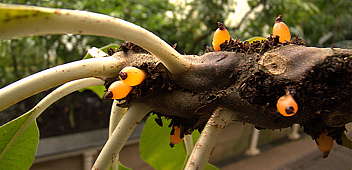
This form of Myrmecodia tuberosa was native to Singapore, although probably extinct in its habitat. Being a traditional 'cure-all' herbal remedy doubtless hastened its exinction.
|
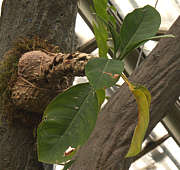 |
Myrmecodia tuberosa Jack 1823
is widely distributed from coastal mangrove forest to elevations over 7000 ft, in Thailand, Vietnam, and through Malaysia to New Guinea and Queensland, Australia. Despite it's caudiciform habit, this succulent plant will not tolerate prolonged drought and prefers bright light to full sunlight.
Small white flowers with 4 petals are followed by orange berries. A traditional herbal remedy.
|







